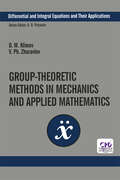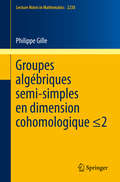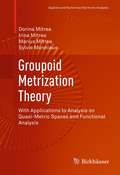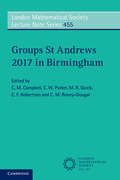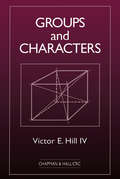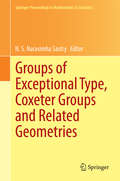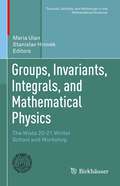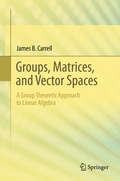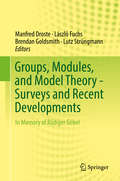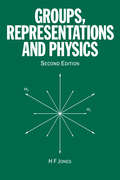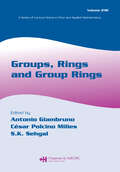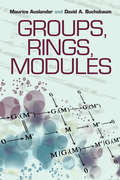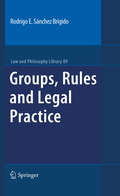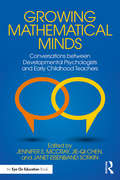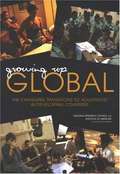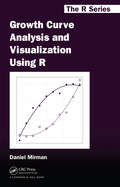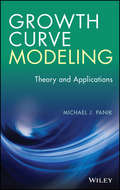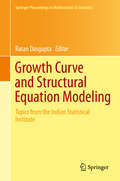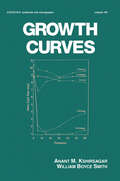- Table View
- List View
Group-Theoretic Methods in Mechanics and Applied Mathematics
by D.M. KlimovGroup analysis of differential equations has applications to various problems in nonlinear mechanics and physics. Group-Theoretic Methods in Mechanics and Applied Mathematics systematizes the group analysis of the main postulates of classical and relativistic mechanics. Exact solutions are given for the following equations: dynamics of rigid body, heat transfer, wave, hydrodynamics, Thomas-Fermi, and more. The author pays particular attention to the application of group analysis to developing asymptotic methods for problems with small parameters. This book is designed for a broad audience of scientists, engineers, and students in the fields of applied mathematics, mechanics and physics.
Groupes algébriques semi-simples en dimension cohomologique ≤2: Semisimple algebraic groups in cohomological dimension ≤2 (Lecture Notes in Mathematics #2238)
by Philippe GilleLa théorie des groupes algébriques sur un corps arbitraire est l’une des branches les plus merveilleuses des mathématiques modernes. Cette monographie porte sur les groupes algébriques semi-simples définis sur un corps k de dimension cohomologique séparable ≤2 et la cohomologie galoisienne d’iceux. La question ouverte la plus importante est la conjecture II de Serre (1962) qui prédit l’annulation de la cohomologie galoisienne d’un groupe semi-simple simplement connexe.Utilisant principalement des techniques de groupes algébriques, on couvre tous les cas connus de la conjecture: les cas classiques (dus à Bayer-Fluckiger and Parimala) ainsi que les avancées sur les cas exceptionnels restants (par exemple de type E8). Ceci s’applique à la classification des groupes semi-simples. The theory of algebraic groups over arbitrary fields is one of the most beautiful branches of modern mathematics. This monograph deals with semisimple algebraic groups over a general field k of separable cohomological dimension ^ to Bayer-Fluckiger and Parimala), and some perspectives are given on the remaining exceptional cases (e.g., G of type E8). Applications to the classification of semisimple k-groups are presented.
Groupoid Metrization Theory
by Marius Mitrea Sylvie Monniaux Dorina Mitrea Irina MitreaThe topics in this research monograph are at the interface of several areas of mathematics such as harmonic analysis, functional analysis, analysis on spaces of homogeneous type, topology, and quasi-metric geometry. The presentation is self-contained with complete, detailed proofs, and a large number of examples and counterexamples are provided. Unique features of Metrization Theory for Groupoids: With Applications to Analysis on Quasi-Metric Spaces and Functional Analysis include: * treatment of metrization from a wide, interdisciplinary perspective, with accompanying applications ranging across diverse fields; * coverage of topics applicable to a variety of scientific areas within pure mathematics; * useful techniques and extensive reference material; * includes sharp results in the field of metrization. Professional mathematicians with a wide spectrum of mathematical interests will find this book to be a useful resource and complete self-study guide. At the same time, the monograph is accessible and will be of use to advanced graduate students and to scientifically trained readers with an interest in the interplay among topology and metric properties and/or functional analysis and metric properties. * coverage of topics applicable to a variety of scientific areas within pure mathematics; * useful techniques and extensive reference material; * includes sharp results in the field of metrization. Professional mathematicians with a wide spectrum of mathematical interests will find this book to be a useful resource and complete self-study guide. At the same time, the monograph is accessible and will be of use to advanced graduate students and to scientifically trained readers with an interest in the interplay among topology and metric properties and/or functional analysis and metric properties. * useful techniques and extensive reference material; * includes sharp results in the field of metrization. Professional mathematicians with a wide spectrum of mathematical interests will find this book to be a useful resource and complete self-study guide. At the same time, the monograph is accessible and will be of use to advanced graduate students and to scientifically trained readers with an interest in the interplay among topology and metric properties and/or functional analysis and metric properties. * includes sharp results in the field of metrization. Professional mathematicians with a wide spectrum of mathematical interests will find this book to be a useful resource and complete self-study guide. At the same time, the monograph is accessible and will be of use to advanced graduate students and to scientifically trained readers with an interest in the interplay among topology and metric properties and/or functional analysis and metric properties. Professional mathematicians with a wide spectrum of mathematical interests will find this book to be a useful resource and complete self-study guide. At the same time, the monograph is accessible and will be of use to advanced graduate students and to scientifically trained readers with an interest in the interplay among topology and metric properties and/or functional analysis and metric properties.
Groups
by Antonio MachìGroups are a means of classification, via the group action on a set, but also the object of a classification. How many groups of a given type are there, and how can they be described? Hölder's program for attacking this problem in the case of finite groups is a sort of leitmotiv throughout the text. Infinite groups are also considered, with particular attention to logical and decision problems. Abelian, nilpotent and solvable groups are studied both in the finite and infinite case. Permutation groups and are treated in detail; their relationship with Galois theory is often taken into account. The last two chapters deal with the representation theory of finite group and the cohomology theory of groups; the latter with special emphasis on the extension problem. The sections are followed by exercises; hints to the solution are given, and for most of them a complete solution is provided.
Groups St Andrews 2017 in Birmingham (London Mathematical Society Lecture Note Series #455)
by C. M. Campbell M. R. Quick E. F. Robertson C. W. Parker C. M. Roney-DougalEvery four years leading researchers gather to survey the latest developments in all aspects of group theory. Initially held in St Andrews, these meetings have become the premier forum for group theory across the whole of the UK. Since 1981, the proceedings of 'Groups St Andrews' have provided a regular snapshot of the state-of-the-art in group theory and helped to shape the direction of research in the field. This volume contains papers from the 2017 meeting held in Birmingham. It includes expository articles from the invited speakers, and further surveys contributed by the participants. Topics include: generation of finite simple groups, block theory, fusion systems, algebraic groups, one-relator groups, geometric group theory, and Beauville groups.
Groups and Characters
by Victor E HillGroup representation theory is both elegant and practical, with important applications to quantum mechanics, spectroscopy, crystallography, and other fields in the physical sciences. This book offers an easy-to-follow introduction to the theory of groups and of group characters. Designed as a rapid survey of the subject, it emphasizes examples and applications of the theorems, and avoids many of the longer and more difficult proofs. The text includes sections that provide the mathematical basis for some of the applications of group theory. It also offers numerous exercises, some stressing computation of concrete examples, others stressing development of the theory.
Groups of Exceptional Type, Coxeter Groups and Related Geometries
by N.S. Narasimha SastryThe book deals with fundamental structural aspects of algebraic and simple groups, Coxeter groups and the related geometries and buildings. All contributing authors are very active researchers in the topics related to the theme of the book. Some of the articles provide the latest developments in the subject; some provide an overview of the current status of some important problems in this area; some survey an area highlighting the current developments; and some provide an exposition of an area to collect problems and conjectures. It is hoped that these articles would be helpful to a beginner to start independent research on any of these topics, as well as to an expert to know some of the latest developments or to consider some problems for investigation.
Groups, Graphs and Random Walks (London Mathematical Society Lecture Note Series #436)
by Tullio Ceccherini-Silberstein Maura Salvatori Ecaterina Sava-HussAn accessible and panoramic account of the theory of random walks on groups and graphs, stressing the strong connections of the theory with other branches of mathematics, including geometric and combinatorial group theory, potential analysis, and theoretical computer science. This volume brings together original surveys and research-expository papers from renowned and leading experts, many of whom spoke at the workshop 'Groups, Graphs and Random Walks' celebrating the sixtieth birthday of Wolfgang Woess in Cortona, Italy. Topics include: growth and amenability of groups; Schrdinger operators and symbolic dynamics; ergodic theorems; Thompson's group F; Poisson boundaries; probability theory on buildings and groups of Lie type; structure trees for edge cuts in networks; and mathematical crystallography. In what is currently a fast-growing area of mathematics, this book provides an up-to-date and valuable reference for both researchers and graduate students, from which future research activities will undoubtedly stem.
Groups, Invariants, Integrals, and Mathematical Physics: The Wisła 20-21 Winter School and Workshop (Tutorials, Schools, and Workshops in the Mathematical Sciences)
by Maria Ulan Stanislav HronekThis volume presents lectures given at the Wisła 20-21 Winter School and Workshop: Groups, Invariants, Integrals, and Mathematical Physics, organized by the Baltic Institute of Mathematics. The lectures were dedicated to differential invariants – with a focus on Lie groups, pseudogroups, and their orbit spaces – and Poisson structures in algebra and geometry and are included here as lecture notes comprising the first two chapters. Following this, chapters combine theoretical and applied perspectives to explore topics at the intersection of differential geometry, differential equations, and category theory. Specific topics covered include:The multisymplectic and variational nature of Monge-Ampère equations in dimension fourIntegrability of fifth-order equations admitting a Lie symmetry algebraApplications of the van Kampen theorem for groupoids to computation of homotopy types of striped surfacesA geometric framework to compare classical systems of PDEs in the category of smooth manifoldsGroups, Invariants, Integrals, and Mathematical Physics is ideal for graduate students and researchers working in these areas. A basic understanding of differential geometry and category theory is assumed.
Groups, Matrices, and Vector Spaces: A Group Theoretic Approach to Linear Algebra
by James B. CarrellTo emphasize the importance of a foundation of knowledge in both geometry and algebra, this text includes an introduction to Euclidean Spaces, and a brief treatment of algebraic topics such as matrix algebra, linear systems, vector spaces, linear coding theory, determinants, eigentheory, group theory, ring theory, and field extensions, even covering an introduction to cryptography.
Groups, Modules, and Model Theory - Surveys and Recent Developments
by László Fuchs Manfred Droste Brendan Goldsmith Lutz StrüngmannThis volume focuses on group theory and model theory with a particular emphasis on the interplay of the two areas. The survey papers provide an overview of the developments across group, module, and model theory while the research papers present the most recent study in those same areas. With introductory sections that make the topics easily accessible to students, the papers in this volume will appeal to beginning graduate students and experienced researchers alike. As a whole, this book offers a cross-section view of the areas in group, module, and model theory, covering topics such as DP-minimal groups, Abelian groups, countable 1-transitive trees, and module approximations. The papers in this book are the proceedings of the conference "New Pathways between Group Theory and Model Theory," which took place February 1-4, 2016, in M#65533;lheim an der Ruhr, Germany, in honor of the editors' colleague R#65533;diger G#65533;bel. This publication is dedicated to Professor G#65533;bel, who passed away in 2014. He was one of the leading experts in Abelian group theory.
Groups, Representations and Physics
by H.F JonesIllustrating the fascinating interplay between physics and mathematics, Groups, Representations and Physics, Second Edition provides a solid foundation in the theory of groups, particularly group representations. For this new, fully revised edition, the author has enhanced the book's usefulness and widened its appeal by adding a chapter on the Cartan-Dynkin treatment of Lie algebras. This treatment, a generalization of the method of raising and lowering operators used for the rotation group, leads to a systematic classification of Lie algebras and enables one to enumerate and construct their irreducible representations. Taking an approach that allows physics students to recognize the power and elegance of the abstract, axiomatic method, the book focuses on chapters that develop the formalism, followed by chapters that deal with the physical applications. It also illustrates formal mathematical definitions and proofs with numerous concrete examples.
Groups, Rings and Group Rings (Lecture Notes in Pure and Applied Mathematics)
by Antonio Giambruno César Polcinn Milies S. K. SehgalThis book is a collection of research papers and surveys on algebra that were presented at the Conference on Groups, Rings, and Group Rings held in Ubatuba, Brazil. This text familiarizes researchers with the latest topics, techniques, and methodologies in several branches of contemporary algebra. With extensive coverage, it examines broad themes f
Groups, Rings, Modules (Dover Books on Mathematics)
by Maurice Auslander David BuchsbaumThis classic monograph is geared toward advanced undergraduates and graduate students. The treatment presupposes some familiarity with sets, groups, rings, and vector spaces. The four-part approach begins with examinations of sets and maps, monoids and groups, categories, and rings. The second part explores unique factorization domains, general module theory, semisimple rings and modules, and Artinian rings. Part three's topics include localization and tensor products, principal ideal domains, and applications of fundamental theorem. The fourth and final part covers algebraic field extensions and Dedekind domains. Exercises are provided at the end of each chapter.
Groups, Rules and Legal Practice
by Rodrigo Eduardo Sánchez BrigidoEver since Hart´s The Concept of Law, legal philosophers agree that the practice of law-applying officials is a fundamental aspect of law. Yet there is a huge disagreement on the nature of this practice. Is it a conventional practice? Is it like the practice that takes place, more generally, when there is a social rule in a group? Does it share the nature of collective intentional action? The book explores the main responses to these questions, and claims that they fail on two main counts: current theories do not explain officials´ beliefs that they are under a duty qua members of an institution, and they do not explain officials´ disagreement about the content of these institutional duties. Based on a particular theory of collective action, the author elaborates then an account of certain institutions, and claims that the practice is an institutional practice of sorts. This would explain officials´ beliefs in institutional duties, and officials´ disagreement about those duties. The book should be of interest to legal philosophers, but also to those concerned with group and social action theories and, more generally, with the nature of institutions.
Growing Mathematical Minds: Conversations Between Developmental Psychologists and Early Childhood Teachers
by Jennifer S. McCray Jie-Qi Chen Janet Eisenband SorkinGrowing Mathematical Minds is the documentation of an innovative, bi-directional process of connecting research and practice in early childhood mathematics. The book translates research on early mathematics from developmental psychology into terms that are meaningful to teachers and readily applicable in early childhood classrooms. It documents teacher responses, and conveys their thoughts and questions back to representative researchers, who reply in turn. In so doing, this highly useful book creates a conversation, in which researchers and teachers each bring their expertise to bear; their communication about these topics—informed by the thinking, commitment, and experience of both groups—helps us better understand how developmental psychology can improve math teaching, and how math teaching can, in turn, inform developmental science. The book bridges the gap between research and practice, helping teachers to adopt evidence-based practices and apply cutting-edge research findings, and prompting developmental researchers to consider their work within the framework of practice. Growing Mathematical Minds identifies and elucidates research with profound implications for teaching children from three to eight years so they develop foundational math knowledge and skills, positive attitudes toward math, and basic abilities to think mathematically.
Growing Patterns: Fibonacci Numbers in Nature
by Sarah C. CampbellAn ALSC Notable Children's BookA wonderful introduction to one of the most beautiful connections between mathematics and the natural world–the Fibonacci sequence–through a series of stunning nature photographs.Discover the biggest mathematical mystery in nature—Fibonacci numbers! Named after a famous mathematician, the number pattern is simple and starts with: 1, 1, 2, 3, 5, 8, 13. Each number in the sequence comes from adding the two numbers before it. What's the mystery? The pattern crops up in the most unexpected places. You'll find it in the disk of a sunflower, the skin of a pineapple, and the spiral of a nautilus shell.This book brings math alive, celebrates science, and will inspire kids to see nature through new eyes.
Growing Up Global: The Changing Transitions to Adulthood in Developing Countries
by National Research CouncilInformation on the Changing Transition to Adulthood in Developing Countries
Growing, Growing, Growing: Exponential Relationships (Texas)
by Glenda Lappan James T. Fey William M. Fitzgerald Susan N. Friel Elizabeth Difanis PhillipsNIMAC-sourced textbook
Growth Curve Analysis and Visualization Using R (Chapman & Hall/CRC The R Series #14)
by Daniel MirmanLearn How to Use Growth Curve Analysis with Your Time Course Data <P><P> An increasingly prominent statistical tool in the behavioral sciences, multilevel regression offers a statistical framework for analyzing longitudinal or time course data. It also provides a way to quantify and analyze individual differences, such as developmental and neuropsychological, in the context of a model of the overall group effects. To harness the practical aspects of this useful tool, behavioral science researchers need a concise, accessible resource that explains how to implement these analysis methods.<P><P> Growth Curve Analysis and Visualization Using R provides a practical, easy-to-understand guide to carrying out multilevel regression/growth curve analysis (GCA) of time course or longitudinal data in the behavioral sciences, particularly cognitive science, cognitive neuroscience, and psychology. With a minimum of statistical theory and technical jargon, the author focuses on the concrete issue of applying GCA to behavioral science data and individual differences. <P><P> The book begins with discussing problems encountered when analyzing time course data, how to visualize time course data using the ggplot2 package, and how to format data for GCA and plotting. It then presents a conceptual overview of GCA and the core analysis syntax using the lme4 package and demonstrates how to plot model fits. The book describes how to deal with change over time that is not linear, how to structure random effects, how GCA and regression use categorical predictors, and how to conduct multiple simultaneous comparisons among different levels of a factor. It also compares the advantages and disadvantages of approaches to implementing logistic and quasi-logistic GCA and discusses how to use GCA to analyze individual differences as both fixed and random effects. The final chapter presents the code for all of the key examples along with samples demonstrating how to report GCA results.<P><P> Throughout the book, R code illustrates how to implement the analyses and generate the graphs. Each chapter ends with exercises to test your understanding. The example datasets, code for solutions to the exercises, and supplemental code and examples are available on the author’s website.
Growth Curve Modeling
by Michael J. PanikFeatures recent trends and advances in the theory and techniques used to accurately measure and model growthGrowth Curve Modeling: Theory and Applications features an accessible introduction to growth curve modeling and addresses how to monitor the change in variables over time since there is no "one size fits all" approach to growth measurement. A review of the requisite mathematics for growth modeling and the statistical techniques needed for estimating growth models are provided, and an overview of popular growth curves, such as linear, logarithmic, reciprocal, logistic, Gompertz, Weibull, negative exponential, and log-logistic, among others, is included.In addition, the book discusses key application areas including economic, plant, population, forest, and firm growth and is suitable as a resource for assessing recent growth modeling trends in the medical field. SAS® is utilized throughout to analyze and model growth curves, aiding readers in estimating specialized growth rates and curves. Including derivations of virtually all of the major growth curves and models, Growth Curve Modeling: Theory and Applications also features:* Statistical distribution analysis as it pertains to growth modeling* Trend estimations* Dynamic site equations obtained from growth models* Nonlinear regression* Yield-density curves* Nonlinear mixed effects models for repeated measurements dataGrowth Curve Modeling: Theory and Applications is an excellent resource for statisticians, public health analysts, biologists, botanists, economists, and demographers who require a modern review of statistical methods for modeling growth curves and analyzing longitudinal data. The book is also useful for upper-undergraduate and graduate courses on growth modeling.
Growth Curve and Structural Equation Modeling
by Ratan DasguptaThis book describes some recent trends in GCM research on different subject areas, both theoretical and applied. This includes tools and possibilities for further work through new techniques and modification of existing ones. A growth curve is an empirical model of the evolution of a quantity over time. Growth curves in longitudinal studies are used in disciplines including biology, statistics, population studies, economics, biological sciences, sociology, nano-biotechnology, and fluid mechanics. The volume includes original studies, theoretical findings and case studies from a wide range of applied work. This volume builds on presentations from a GCM workshop held at the Indian Statistical Institute, Giridih, January 18-19, 2014. This book follows the volume Advances in Growth Curve Models, published by Springer in 2013. The results have meaningful application in health care, prediction of crop yield, child nutrition, poverty measurements, estimation of growth rate, and other research areas.
Growth Curves (Statistics: A Series of Textbooks and Monographs)
by William Smith Anant KshirsagarThis work describes several statistical techniques for studying repeated measures data, presenting growth curve methods applicable to biomedical, social, animal, agricultural and business research. It details the multivariate development of growth science and repeated measures experiments, covering time-moving covariates, exchangable errors, bioassay results, missing data procedures and nonparametric and Bayesian methods.
Growth Experience in Transition Countries, 1990-98
by International Monetary FundA report from the International Monetary Fund.
